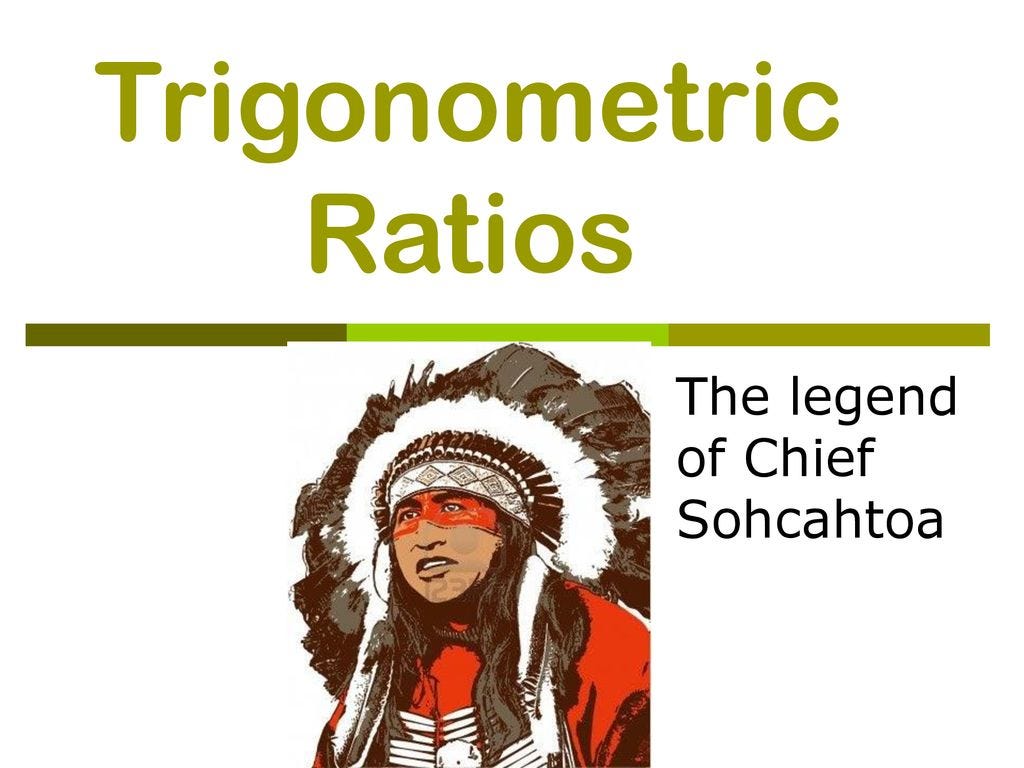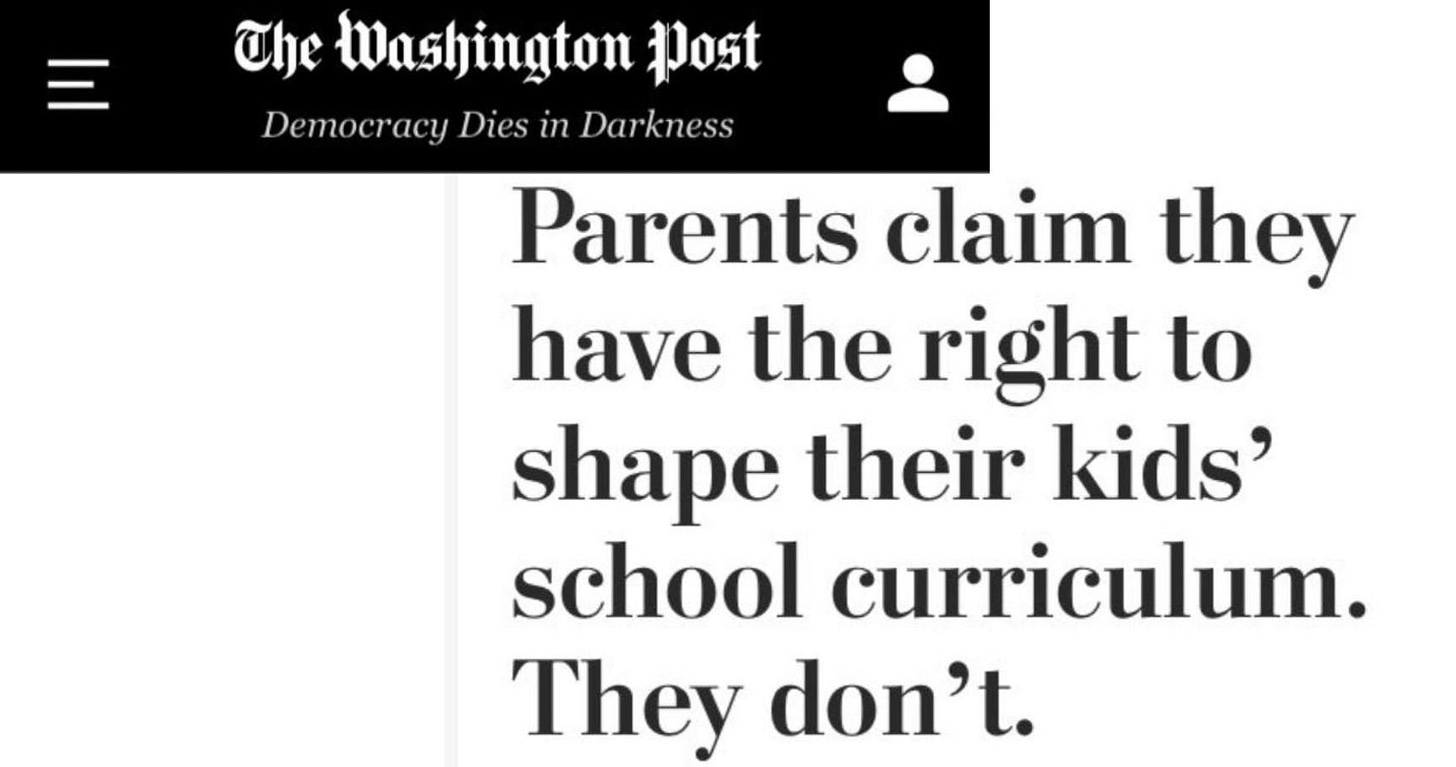The Future is Local: SOHCAHTOA and the Jab
It’s not an indie band name
In mid-October 2021, a scandal erupted in the southern California city where I live when a video of a trigonometry teacher went viral. Recorded by a student in the class where it happened, the video depicts the teacher wearing a cardboard headdress while doing a cartoonish and embarrassing “Indian dance” that bore no substantive resemblance to anything truly Native American. The tsunami of rage that built over the rest of that day (in the high-speed times in which we live, 12 hours can feel like 12 days) crashed into the regularly-scheduled school board meeting that very night. Tribal leaders, the Black Panthers, the local Brown Beret native-supremacists, and even a former officer of the local NAACP chapter showed up in force, shouting “all power to the people” and declaring with one voice a clear and unequivocal demand: the teacher should be fired immediately, no investigation was needed, and “we” would stand for nothing less. One went so far as to declare that the teacher should be barred from the profession for life. Another put an ominous one-week deadline on the process, implying that “consequences” would follow should the school district take longer than that to “act.”
Around and behind the outrage (and only on social media--none dared oppose this crowd in person), a variety of brave souls ventured to find an explanation for what the teacher even thought she was doing. And as it turns out, while this lesson plan was certainly tone-deaf and silly there was no evil intent. The teacher was teaching how to calculate sine, cosine, and tangent, specifically via a mnemonic device that has been used in math classrooms for decades: SOHCAHTOA. Somehow over the years, a variety of SOHCAHTOA lesson plans have been developed that present the mnemonic as a faux-Indian word; a quick Google search turned up five such lesson plans on the first page of hits alone. Many such lesson plans involve a campfire-story-style fable about an Indian boy (or girl, or chief) and how they got the name SOHCAHTOA.
It could be recognized at this stage that “a generation ago this would be considered harmless,” but in fairness we no longer live a generation ago, so many of the ideas and motivations of a generation ago don’t bear very heavily on today’s world. And in today’s world it is clear that several very vocal groups find this an unacceptable caricature of Native American culture. They have every right to feel as they do. And even for those that don’t, this is clearly embarrassing. It is hard to watch the recording of the teacher flailing around her room breathlessly chanting SOH-CAH-TO-A and not be embarrassed for her. The reaction from her students (the audio is pretty good) is at best uncertain. They seem to find the whole thing awkward, which is a far cry from unconsciously perpetuating racist stereotypes. Kids often recognize when something feels off, and it’s pretty clear in the video that the kids feel like something is off. While online “investigators” discovered she had been doing this for about ten years now, I’d be willing to bet a dollar that the teacher picked up on her students’ reaction, too, and this may well have been the last “Indian dance” performed in her classroom even without massive public backlash. Good teachers evaluate their methods and discard things that are no longer working in favor of trying other things. And the plucky few willing to be character witnesses for the teacher (with care to agree that this dance thing should be retired post-haste) were unanimous in their declarations that “she’s actually a really good teacher” and “cares about her kids”. Cultural evolution is generational.
My point in summarizing all this, however, is to highlight the proposed solution of the very vocal objectors: government force. The basic line (she must be fired, maybe for life, from teaching) is an appeal to government to “do something.” I was in the room for that school board meeting (more on why in a moment), and without exception the call was the same: government (the school board) had to “do something” about this. The government had to “protect kids” from “harm” by firing this teacher for her racial transgression. Even amid all the outrage over “generational inequities,” “stolen land,” and “cultural genocide,” no commenter suggested that they would be pulling their kids out of school over this. Everybody wanted the school to conform to their desires.
Sit with that a moment. There is a compare and contrast lesson here, which I hope will become clear as we go.
On this particular October evening at this particular school board meeting, there was no agenda item on the SOHCAHTOA incident. Indeed, by law there could not have been one, given the open meeting requirements regarding agendas. So the calls of outrage and racial injustice happened during the general-purpose public comment period at the start of the meeting. It took two and a half hours to get to the end of that comment period, so the board called a five-minute recess once it was over so everyone could regroup for the rest of the meeting. During that time, those who had come to protest the teacher packed up and left, having said their piece.
Once the break was over, the next item on the agenda was a review of the district COVID-19 vaccination mandate policy. Some of you might be able to see where I’m going with this.
My particular school district has never wholeheartedly set up a policy regarding vaccination and testing for COVID-19, preferring the shrugging “we’re just following the state guidelines” approach. It’s not a stretch to believe that they’ve been secretly hoping the case numbers would drop sufficiently for the state to lift the mandates, sparing the local school board the duty of doing anything. No such luck. In practice, this means the district vax/test policy is a half-baked afterthought, which is the worst possible choice given that it could result in teachers losing their jobs. This was why I (and a compatriot from the local Libertarian party) had come to this school board meeting: to read a county party declaration against mandates.
As it happened, we were not alone. A growing population of teachers and parents has been showing up at board meetings for months now, growing increasingly louder (and more comfortable and articulate at the mic) in their opposition to the jab mandates as time has gone on. The opening of the comment period on this agenda item thus brought on a new round of ringing denunciations of the school board. And while the cause of the outrage differed from that of the racial protests earlier, the action demanded this go-round was the same: the board had a duty to act to protect kids and teachers, and they needed to do something. In this case, defy the state mandates.
But creeping into this set of passionate public comments were a few mentions of a much different response. One teacher, unwilling to take the jab and feeling discriminated against by being required to test at a folding table in a public parking lot (thus revealing her vax status to all onlookers) intimated that she and other credentialed teachers were looking at starting their own home-school facilitation business. One parent did the math for the board about the kind of money the district stands to lose in per-pupil daily attendance outlays if even 5% of the families in the district pull their kids over mandates (spoiler: it’s millions of dollars). The idea that the school board wasn’t going to help, and that alternate solutions were going to need to be investigated, was a new but clearly growing idea in this particular group of upset constituents.
They’ve got the right idea. And to all those who believe the government can fix “the” problem with public education (whatever it may be today), I gently say: think again. Government has created all of these problems. An entire industry has built itself around the idea that government schools don’t need your help. Experts trained by experts can expertly plan expert instruction, and anything you have to say about it is a function of your benighted ignorance of the problems the experts are facing. Witness a Washington Post OpEd headline that appeared the same day as this ill-fated California school board meeting.
Government schools have no intention of conforming to your preferences. They never have, and they never will. There is no fix for that. One more policy adoption will not fix public education. One more galactically bloated teacher training scheme will not fix public education. Public education will never be able to satisfy the diversity and inclusion demands of intersectional crytpomarxist race-hustlers. Public education will never be able to satisfy the freedom and conscientious objection demands of bitter gun- and religion-clinging snake-dancers. Wherever you land on the political spectrum, public education can never satisfy you. It will always disappoint you. No amount of internal public education “improvement” will fix that (if the public education establishment was even willing to try, which it is not).
What will fix public education is competition. Nobody’s coming to save you. If you want better educational outcomes for your children for any reason, from racial injustice to bodily autonomy, you cannot continue to hope that government will make it happen for you. You must build it yourself.
That is not going to be easy. It will require personal work and investment (in time, energy, and money) from local people in local places. One of those people will have to be you. It will also require coming to grips with the reality that public education, which we have all been taught to think “binds communities together,” “seemed fine when I was growing up,” or “surely can be fixed if we all come together,” doesn’t, wasn’t, and can’t. It will also require that you stop appealing to government to force your neighbors to pretend to agree with you, and instead sit down with your neighbors face to face, hear each other out, and respectfully agree to disagree.
That’s a hard paradigm shift. But more and more people are making the shift. You can too. And when it comes to education, it has never been easier to walk away. Suzy Weiss has a great piece exploring this idea, and there are many many others.
The future is local. If you want to fix the future you must do so locally.



